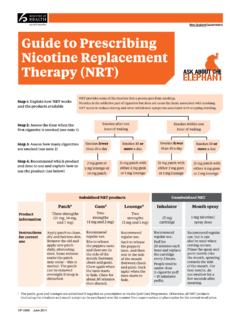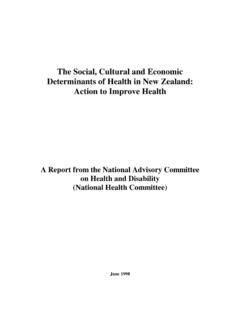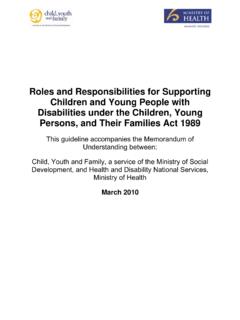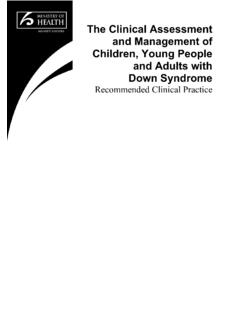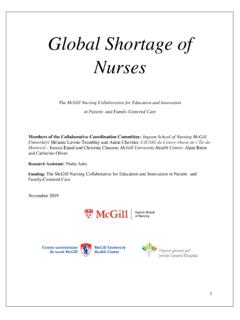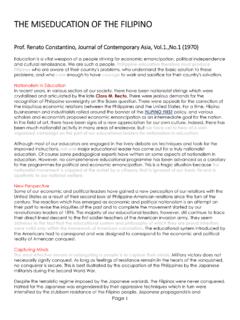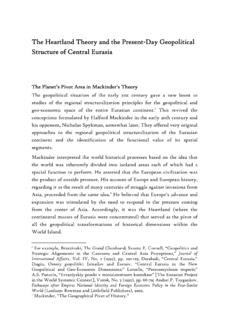Transcription of Achieving equity in health outcomes
1 Released 2018 Achieving equity in health outcomes Highlights of important national and international papers This report has been prepared by the Ministry of health s Achieving equity in health outcomes programme. For more information on the programme please go to: Citation: Ministry of health . 2018. Achieving equity in health outcomes : Highlights of important national and international papers. Wellington: Ministry of health . Published in September 2018 by the Ministry of health PO Box 5013, Wellington 6140, New Zealand ISBN 978-1-98-853994-2 (online) HP 6934 This document is available at This work is licensed under the Creative Commons Attribution International licence. In essence, you are free to: share ie, copy and redistribute the material in any medium or format; adapt ie, remix, transform and build upon the material.
2 You must give appropriate credit, provide a link to the licence and indicate if changes were made. Achieving equity IN health outcomes : HIGHLIGHTS OF IMPORTANT NATIONAL AND INTERNATIONAL PAPERS iii Contents Why Achieving equity matters more than ever 1 Context and history of health equity 2 International context 2 Evolving definitions of health equity 4 The underlying principles and ethics of equity 5 Horizontal and vertical equity 7 Measuring health equity 8 The economics of health equity 9 How some jurisdictions approach health equity 10 International writing 12 New Zealand s context and history of health equity 14 Treaty of Waitangi 14 Hauora and Whaiora: M ori health development 15 Hui Taumata and equity 16 Considerations of racism and equity 18 Economics of health equity in New Zealand 20 Rethinking equity in health 20 In a nutshell 25 References 26 Achieving equity IN health outcomes : HIGHLIGHTS OF IMPORTANT NATIONAL AND INTERNATIONAL PAPERS 1 Why Achieving equity matters more than ever The inverse care law states the availability of health care varies inversely with the population s need for it; in effect, those most in need of health care have the least access to it (Hart 1971).
3 Both in New Zealand and globally, our ability to address equity challenges in health has improved significantly over the past decades. In the Western world, life expectancy has increased for all populations. However, persistent disparities in health access, quality of services and outcomes remain. In Aotearoa New Zealand, M ori and Pacific peoples and those in low socioeconomic groups are still the most disadvantaged. The Government has mandated the Ministry of health (the Ministry) to take a bold approach to addressing healthy inequities that delivers tangible changes to health system behaviour, with measurable results over a three- to five-year horizon. The Ministry is developing an approach that operates on a repeating cycle based around deepening the understanding of equity gaps, shifting thinking about where priorities for investment of time and resources should lie, followed by increasing direct action to address inequalities.
4 This paper traces the beginnings of health equity and the philosophical and ethical foundations that sit behind this approach. It looks at a selection of the international and local literature to help understand definitions of equity . It considers how framing and thinking about the concept of equity and approaches to addressing equity have evolved, as well as how we can measure progress in addressing equity issues. 2 Achieving equity IN health outcomes : HIGHLIGHTS OF IMPORTANT NATIONAL AND INTERNATIONAL PAPERS Context and history of health equity International context Writing about the social disparities in health has a long history, dating back in modern history at least to the writings of Frederick Engels.
5 In 1845, in his article The condition of the working class in England , Engels asked How is it possible .. for the lower class to be healthy and long-lived? What else can be expected than an excessive mortality, an unbroken series of epidemics, and a progressive deterioration in the physique of the working population? The concept of health equity was strongly endorsed by participants in the World health Organization s (WHO) Conference on Primary health Care in Alma-Ata in 1978 (WHO 1978). The Declaration of Alma-Ata viewed health as part of and an impetus for development, with every social sector needing to collaborate in the production and maintenance of health for All . Clean water and sanitation systems were necessary to control diarrheal diseases; improved conditions of housing and shelter were needed to contain tuberculosis and respiratory disorders; good nutrition was an important foundation of good health and poverty was the foundation of much illness.
6 The declaration highlighted the inequality between developed and developing countries and termed it politically, socially and economically unacceptable (WHO 1978). The launch of the health for All campaign implicitly made health equity a priority for all countries (Mahler 1981). Michael Marmot is arguably the best known commentator on health equity , having carried out many studies into health equity , the social determinants of health and the social gradient. His Whitehall studies of a large cohort of British civil servants, published in 1978, convincingly demonstrated that a social class-based health gradient existed even among the well-educated and employed (Marmot et al 1978). Marmot identified that the emerging problems of differential health outcomes and health status were not limited to minorities and the poor.
7 Additionally, increasingly researchers recognised that particular community and societal level factors, including stress (Marmot 1986; Sapolsky and Mott 1987), early life experiences (Tager et al 1983), social capital (Coleman 1988) and income inequality (Wilkinson 1992a, b) seemed to exert significant effects on health and disease outcomes , independent of personal behaviour. The impetus for growing the policy relevance of the social determinants of health was provided by the Black report. This report, titled Inequalities in health , was published in 1980 in the United Kingdom. It described and analysed the existing social inequalities and proposed government actions to overcome them. Achieving equity IN health outcomes : HIGHLIGHTS OF IMPORTANT NATIONAL AND INTERNATIONAL PAPERS 3 By 1983, the leading international health economist Gavin Mooney was addressing the ethical dimensions of inequalities, using the term equity in his discussion of the implications for health service resource allocation of: equal expenditure per capita equal resources per capita equal resources for equal needs equal opportunity of access for equal needs equal utilisation for equal needs equal extent of meeting priorities equal health outcomes (Mooney 1983).
8 In the years following the Alma-Ata conference, the WHO regional office for Europe established a programme on equity in health to examine issues of unemployment, poverty and health , with reference to several vulnerable groups. A strong network of experts provided a wealth of information and insights into the problem and put equity firmly on the political agenda in member states. In 1990, the regional office commissioned renowned researcher and Professor in Public health Margaret Whitehead to write a report explaining the concept of health equity . The result was the highly influential article The concepts and principles of equity and health (Whitehead 1991). The WHO undertook a global initiative on equity in health and health care in 1995 to focus the attention of governments and international agencies on health equity within and between countries (Braveman et al 1996).
9 In 1999, they embarked on a new method for measuring health disparities, looking at overall differences between healthy and sick ungrouped individuals within a country rather than comparing health across predetermined social groups. This ungrouped approach rejected the thinking by most experts that individuals should be categorised by markers of underlying social advantage. Many researchers argued that, in doing this, they silenced the ethical and social justice aspect that is at the heart of equity in health (Braveman et al 2003). The WHO reverted to their original approach of measuring disparities between different social groups in 2004. In 2011 at Rio de Janeiro, the WHO s health equity -dedicated Commission on the Social Determinants of health reaffirmed its focus on equity and the principles of the 1978 Alma-Ata Declaration.
10 It stated: [3] The enjoyment of the highest attainable standard of health is one of the fundamental rights of every human being without distinction of race, religion, and political belief, economic or social condition . We recognize that governments have a responsibility for the health of their peoples, which can be fulfilled only by the provision of adequate health and social measures and that national efforts need to be supported by an enabling international environment. 4. We reaffirm that health inequities within and between countries are politically, socially and economically unacceptable, as well as unfair and largely avoidable, and that the promotion of health equity is essential to sustainable development and to a better quality of life and well-being for all, which in turn can contribute to peace and security.
